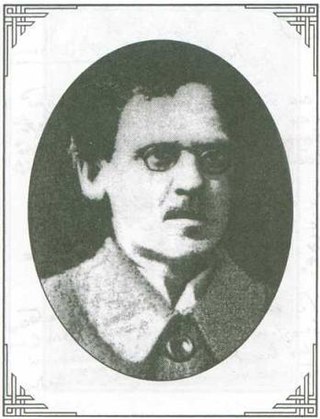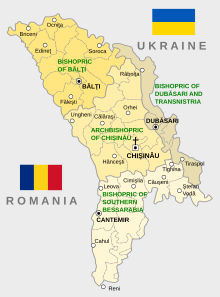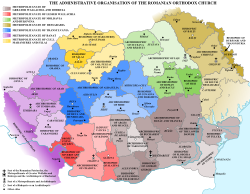The history of Moldova can be traced to the 1350s, when the Principality of Moldavia, the medieval precursor of modern Moldova and Romania, was founded. The principality was a vassal of the Ottoman Empire from 1538 until the 19th century. In 1812, following one of several Russian–Turkish wars, the eastern half of the principality, Bessarabia, was annexed by the Russian Empire. In 1918, Bessarabia briefly became independent as the Moldavian Democratic Republic and, following the decision of the Parliament, united with Romania. During the Second World War it was occupied by the Soviet Union which reclaimed it from Romania. It joined the Union as the Moldavian ASSR, until the dissolution of the USSR. In 1991 the country declared independence as the Republic of Moldova.

The Romanian Orthodox Church, or Patriarchate of Romania, is an autocephalous Eastern Orthodox church in full communion with other Eastern Orthodox Christian churches, and one of the nine patriarchates in the Eastern Orthodox Church. Since 1925, the church's Primate has borne the title of Patriarch. Its jurisdiction covers the territories of Romania and Moldova, with additional dioceses for Romanians living in nearby Serbia and Hungary, as well as for diaspora communities in Central and Western Europe, North America and Oceania. It is the only autocephalous church within Eastern Orthodoxy to have a Romance language for liturgical use.

Moldova's constitution provides for freedom of religion and complete separation of church and state, though the constitution cites the "exceptional importance" of Eastern Orthodox Christianity. Discrimination on the basis of religious affiliation is illegal, and incitement to religious and ethnic hatred was made illegal in May 2022. Religion in Moldova is dominated by the Eastern Orthodox branch of Christianity. According to the 2014 Moldovan census, 90 per cent of the country reported to be of the Eastern Orthodox Christian faith. Of this number, around eighty to 90 per cent of Orthodox Moldovans belong to the Moldovan Orthodox Church which is subordinate to the Russian Orthodox Church, and has played a powerful role in deepening Russia's influence in Moldova. The remaining 10–20 per cent of Orthodox Moldovans belong to the Metropolis of Bessarabia, which is subordinate to the Romanian Orthodox Church.

The Metropolis of Chișinău and All Moldova, also referred to as the Moldovan Orthodox Church, is an autonomous metropolitanate under the Russian Orthodox Church. Its canonical territory is the Republic of Moldova.

The Eastern Orthodox Church in Moldova is represented by two jurisdictions -- the Metropolis of Chișinău and All Moldova, commonly referred to as the Moldovan Orthodox Church, a self-governing church body under the Russian Orthodox Church, and by the Metropolis of Bessarabia, also referred to as the Bessarabian Orthodox Church, a self-governing church body under the Romanian Orthodox Church. According to a 2011 Gallup survey on religion, among the Eastern Orthodox of Moldova, 86% belonged to the Moldovan Orthodox Church, while 13% belonged to the Bessarabian Orthodox Church. Other Orthodox jurisdictions - non canonical ones included - have few other parishes in the region.

The Bessarabia Governorate was a province (guberniya) of the Russian Empire, with its administrative centre in Kishinev. It consisted of an area of 45,632.42 square kilometres (17,618.78 sq mi) and a population of 1,935,412 inhabitants. The Bessarabia Governorate bordered the Podolia Governorate to the north, the Kherson Governorate to the east, the Black Sea to the south, Romania to the west, and Austria to the northwest. It roughly corresponds to what is now most of Moldova and some parts of Chernivtsi and Odesa Oblasts of Ukraine.

Gavril Bănulescu-Bodoni was a Romanian clergyman who served as Metropolitan of Moldavia (1792), Metropolitan of Kherson and Crimea (1793–1799), Metropolitan of Kiev and Halych (1799–1803), Exarch of Moldo-Wallachia (1806–1812), and Archbishop of Chișinău (1812–1821), being the first head of the church in Bessarabia after the Russian annexation.

Alexandru Baltagă was a Bessarabian Romanian Orthodox priest, a founder of the Bessarabian religious press in the Romanian language, a member of Sfatul Țării (1917–1918), a Soviet political prisoner, and, according to the Orthodox Church, a martyr for the faith.

The Metropolis of Moldavia and Bucovina, in Iași, Romania, is a metropolis of the Romanian Orthodox Church.
The National Moldavian Party was a political party in Bessarabia.

Anton Crihan was a Bessarabian politician, lawyer, author, economist, professor and journalist. He was a member of Sfatul Țării (1917), adviser to the Secretary of State for Agriculture in the General Directorate of the Republic of Moldova (1917), deputy in the Parliament of Romania, adviser to the Secretary of State at the Ministry of Agriculture and Domains (1932–1933), professor at the Polytechnic University of Iasi and at the Faculty of Agronomy in Chisinau (1934–1940).

Petru Păduraru is a Moldovan Eastern Orthodox prelate and the current Metropolitan of Bessarabia within the Romanian Orthodox Church.

Gurie Grosu was a Bessarabian priest and the first holder of the Basarabian Metropolitan Church after 100 years of Russian occupation. His Christian name was Gheorghe, and he took the name of Gurie when became a monk. Gurie was an extremely devout man and one of the promoters of Romanianism in Bessarabia.

Iustin Ștefan Frățiman, also known as Frațman or Frățimanu, was a historian, educator, librarian and political figure from Bessarabia, active in the Russian Empire and the Kingdom of Romania. After receiving a classical education, he worked for various seminaries of the Russian Orthodox Church, moving as far north as Olonets. Frățiman had settled in Soroca by the time of World War I, becoming a champion of Romanian nationalism. This resulted in his being exiled to Central Asia until 1917. Allowed back home after the liberal February Revolution, he resumed his activism, openly campaigning for the national rights of Romanians east of Bessarabia. He was afterwards one of the educators tasked with institutional Romanianization by the Moldavian Democratic Republic.

Vladimir (Cantarean), (born Nicolae Cantarean on 18 August 1952), is a bishop of the Moldovan Orthodox Church under the Moscow Patriarchate. He serves as Metropolitan of Chișinău and All Moldova and thus as first hierarch of the Church of Moldova and as a permanent member of the Holy Synod of the Russian Orthodox Church.
The Diocese of Chișinău is an eparchy or diocese of the Metropolis of Chișinău and All Moldova under the Moscow Patriarchate with its seat in the capital city of Moldova, Chișinău.

The Diocese of Ungheni and Nisporeni is an eparchy or diocese of the Metropolis of Chișinău and All Moldova under the Moscow Patriarchate with its seat in the city of Ungheni, Moldova.
Bishop Peter or Petru, is a bishop of the Moldovan Orthodox Church under the Moscow Patriarchate. He serves as Bishop of Ungheni and Nisporeni, a diocese of the Russian Orthodox Church in Moldova.

Ieremia Teodor Cecan was a Bessarabian-born Romanian journalist, Bessarabian Orthodox priest and political figure. During the first part of his life, he was active in the Bessarabia Governorate of the Russian Empire, earning his reputation as a Christian philanthropist and putting out the pioneering church magazine Nashe Obyedineniye. His opposition to Russification and his advocacy of social improvement led to a public scandal and then to is demotion by church officials, and pushed Cecan into independent journalism. However, his sympathies remained with the conservative-antisemitic Union of the Russian People, developing into a critique of Romanian nationalism that was well liked by the imperial authorities. During the latter stages of World War I, Cecan was a chaplain in the Russian Army.



















